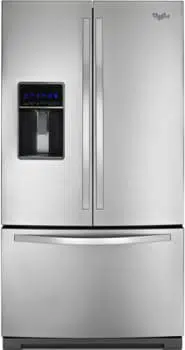Documents: Go to download!
User Manual
- User Manual - (English, French, Spanish)
- Quick Guide - (English)
- Energy Guide - (English)
- Dimension Guide - (English)
FRENCH DOOR BOTTOM MOUNT REFRIGERATOR
PARTS AND FEATURES
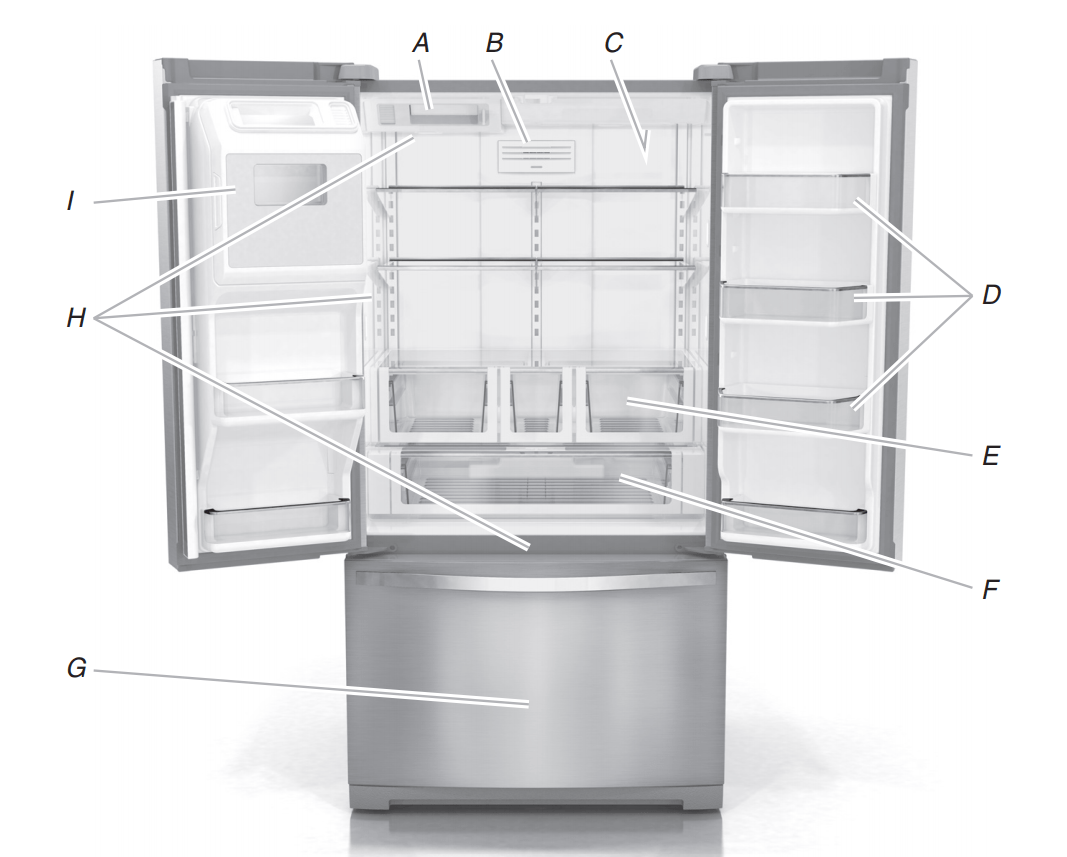 | A. Ice maker B. Air filter C. Water filter D. Door bins E. Crispers F. Pantry drawer G. Freezer drawer H. LED ramp-on lighting I. In-Door-Ice® ice dispensing system |
Energy and Normal Operating Sounds
Your new French Door Bottom Mount refrigerator has been designed to optimize energy efficiency, and better regulate temperatures to match cooling demand. You may notice that it operates differently from your previously owned refrigerator. It is normal for the high-efficiency compressor to run for extended periods of time at varying speeds in order to consume only the energy necessary for optimum efficiency. In addition, during various stages of the cooling cycle, you may hear normal operating sounds that are unfamiliar to you.
More Storage Space
The French Door Bottom Mount has the most fresh food storage space available, including a full-width, temperature controlled, pantry drawer perfect for storing veggie trays or party platters.
In-Door-Ice® Ice Dispensing System
The ice storage bin located in the door provides an entire extra shelf of storage space, and the storage bin is removable for easy access to filtered ice.
Dual Evaporator (on some models)
The refrigerator and freezer compartments have dedicated evaporators to provide fresh and frozen foods with separate climates. Frozen food stays cold and dry, while fresh food remains at the ideal temperature and humidity.
Water Filter
NSF® Certified filter reduces chlorine taste and odor, particulates (class I), lead, and mercury. Replacing the water filter every 6 months ensures clean, filtered drinking water.
Air Filter
An air filter is 15 times more powerful than baking soda at reducing common food odors inside the refrigerator.
Produce Preserver (on some models)
Ethylene is a natural gas produced by fruits and vegetables to promote ripening. The Produce Preserver absorbs ethylene, to delay the over-ripening of fresh produce. As a result, certain produce items will stay fresh longer.
Water Dispenser with Measured Fill (on some models)
The measured fill feature allows you to dispense the desired amount of filtered water.
LED Lighting
The LED lights do not ever need to be replaced.
Door Alarm
A helpful alarm sounds when the refrigerator door or freezer drawer is left ajar.
Power Outage Indicator
If the power should go out while you are away from home, this indicator will let you know the refrigerator has been without power.
INSTALLATION INSTRUCTIONS
NOTE: Measure the width of your door opening, to see whether or not you need to remove the refrigerator doors to move the refrigerator into your home. If door removal is necessary, see the following instructions.
IMPORTANT: If the refrigerator was previously installed and you are moving it out of the home, before you begin, turn the refrigerator control OFF. Unplug the refrigerator or disconnect power. Remove food and adjustable door or utility bins from doors. Gather the required tools and read all instructions before removing doors.
TOOLS NEEDED: ³⁄₁₆" hex key wrench and a #2 Phillips screwdriver
Remove Right-Hand Refrigerator Door
1. Unplug refrigerator or disconnect power.
2. Keep the refrigerator doors closed until you are ready to lift them free from the cabinet.
NOTE: Provide additional support for the refrigerator door while the hinges are being removed. Do not depend on the door gasket magnets to hold the door in place while you are working.
3. Using a Phillips screwdriver, remove the cover from the Top Hinge.
4. Using the ³⁄₁₆" hex key wrench, remove the two internal hex head screws from the top hinge, and set aside.
NOTE: Do not remove the two locator screws. These screws will help you align the hinge when you replace the door.
 | A. Top hinge cover screw C. 3⁄16" Internal hex head screws |
5. Lift the refrigerator door from the bottom hinge pin. The top hinge will come away with the door.
Remove Left-Hand Refrigerator Door
IMPORTANT: The tubing and wiring for the water dispenser run through the left-hand door hinge, so they must be disconnected before removing the door.
| 1. Using a Phillips screwdriver, remove the cover from the top hinge. | 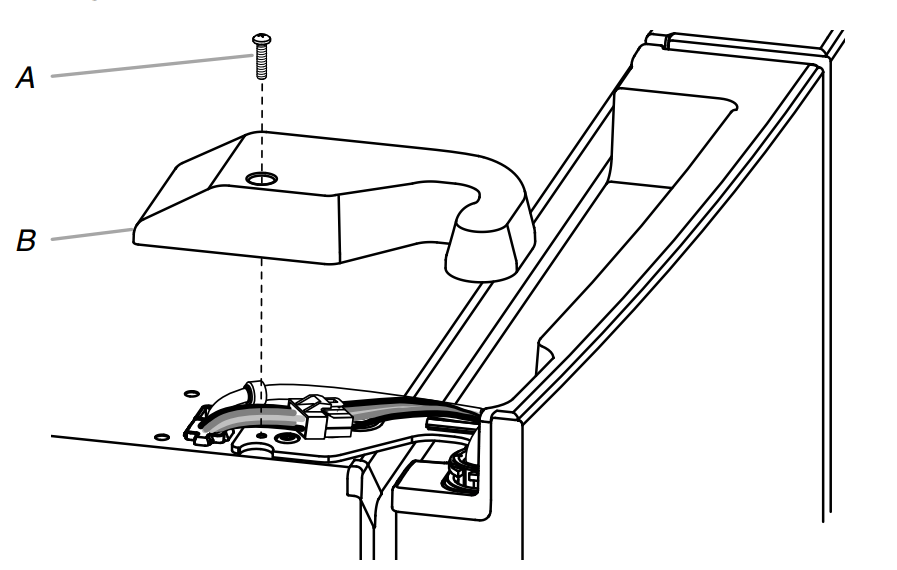 A. Top hinge cover screw B. Top hinge cover |
| 2. Disconnect the water dispenser tubing located on top of the door hinge. | |
Style 1 - Press the outer ring against the face of the fitting and gently pull the dispenser tubing free. NOTE: The water dispenser tubing remains attached to the left-hand refrigerator door. |  A. Outer ring |
Style 2 - Firmly pull up on the clasp. Then, pull the tubing out of the fitting. NOTE: The water dispenser tubing remains attached to the left-hand refrigerator door. |  |
3. Disconnect the wiring plug located on top of the door hinge. ■ Grasp each side of the wiring plug. With your left thumb, press down to release the catch and pull the sections of the plug apart. | 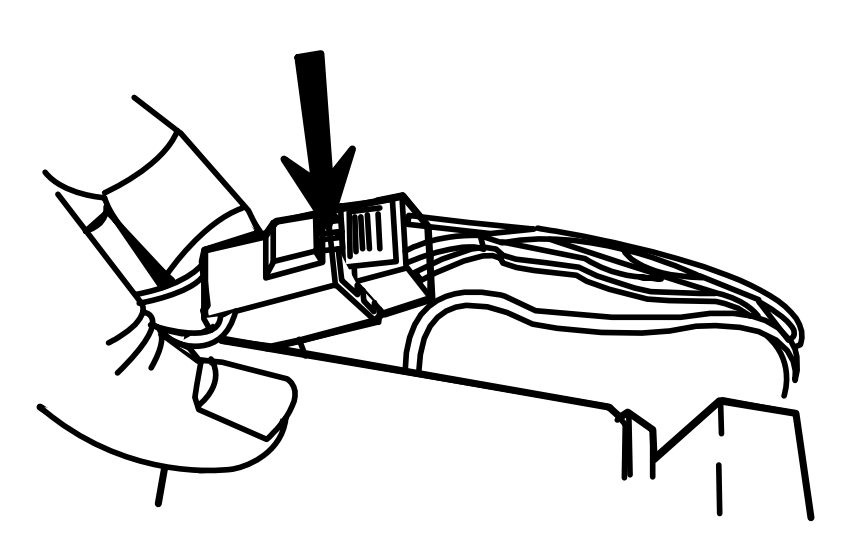 |
4. Using the ³⁄₁₆" hex key wrench, remove the two internal hex head screws from the top hinge, and set aside. NOTES: ■ Provide additional support for the refrigerator door while the hinges are being removed. Do not depend on the door gasket magnets to hold the door in place while you are working.
| 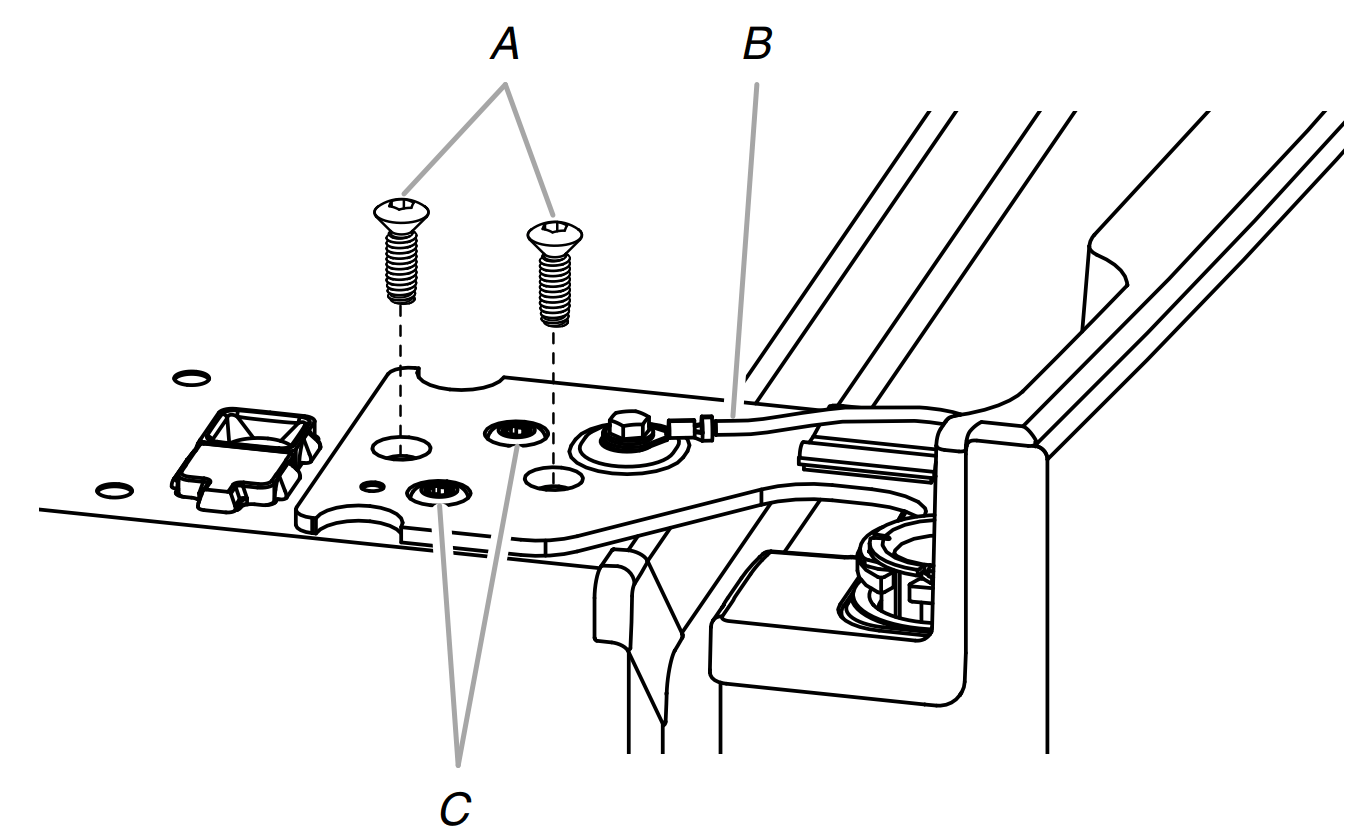 |
5. Lift the refrigerator door from the bottom hinge pin. The top hinge will come away with the door. NOTE: It may not be necessary to remove the bottom hinges and brake feet assemblies to move the refrigerator through a doorway.
| |
Replace Right-Hand Refrigerator Door
- Set the right-hand door onto the bottom hinge pin.
- Insert the top hinge pin into the open hole in the top of the refrigerator door.
- Using the two ³⁄₁₆" internal hex head screws, fasten the hinge to the cabinet. Do not tighten the screws completely.
Replace Left-Hand Refrigerator Door
IMPORTANT: Do not intertwine the water tubing and wiring bundles when reconnecting them.
1. Set the left-hand door onto the bottom hinge pin.
2. Using the two ³⁄₁₆" internal hex head screws, fasten the hinge to the cabinet. Do not tighten the screws completely.
3. Reconnect the water dispenser tubing.
■ Style 1 - Insert the tubing into the fitting until it stops and the outer ring is touching the face of fitting.
■ Style 2 - Insert the tubing firmly into the fitting until it stops. Close the clasp around the tubing. The clasp snaps into place between the fitting and the collar.
4. Reconnect the electrical wiring.
■ Push together the two sections of the wiring plug.
Final Steps
1. Completely tighten the four internal hex head screws (two on the right-hand door hinge and two on the left-hand door hinge).
2. Replace both top hinge covers.
Remove and Replace Freezer Drawer Front
Depending on the width of your door opening, it may be necessary to remove the freezer drawer front to move the refrigerator into your home.
IMPORTANT:
■ If the refrigerator was previously installed and you are moving it out of the home, before you begin, turn the refrigerator control OFF, and unplug the refrigerator or disconnect power. Remove food from the freezer drawer.
■ Two people may be required to remove and replace the freezer drawer front.
Tool Needed: ¹⁄₄" hex driver
Remove Drawer Front
1. Open the freezer drawer to its full extension.
2. Remove the two screws at the top, inside the drawer front (one on the left-hand side and one on the right-hand side) that fasten the drawer front to the drawer glides.
3. Lift up on the drawer front to release the plastic studs from the drawer glide bracket slots.
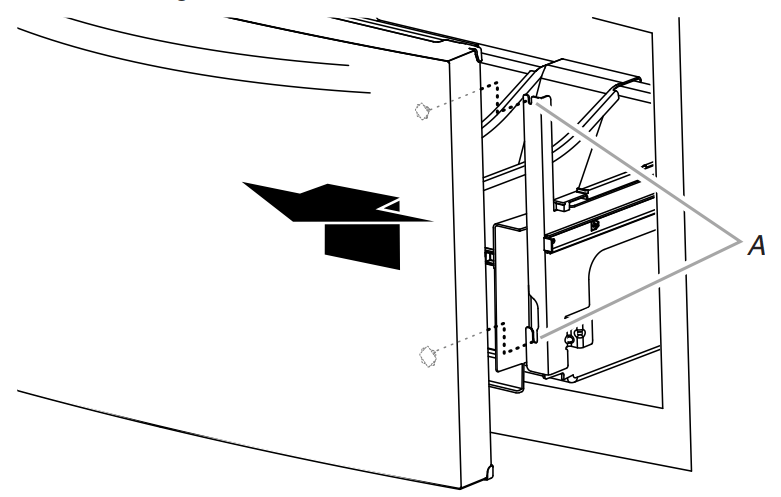
A. Drawer glide bracket slots
4. Slide the drawer glides back into the freezer.
Replace Drawer Front
1. Pull out the freezer drawer glides to their full extension.
2. Holding the drawer front by its sides, align the two plastic studs, located at the bottom, inside the drawer front, with the drawer glide bracket slots.
NOTE: It helps if one person holds the drawer glides steady while another person aligns the drawer front and inserts the studs into the slots
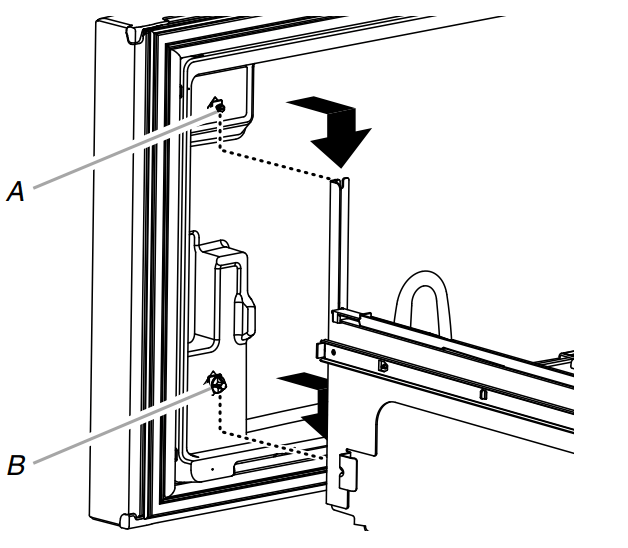
A. Drawer front screw
B. Drawer front plastic stud
3. Replace and tighten the two screws at the top of the drawer front (one on the left-hand side and one on the right-hand side)
Connect the Water Supply
IMPORTANT:
■ Plumbing shall be installed in accordance with the International Plumbing Code and any local codes and ordinances.
■ The gray water tubing on the back of the refrigerator (which is used to connect to the household water line) is a PEX (cross-linked polyethylene) tube. Copper and PEX tubing connections from the household water line to the refrigerator are acceptable, and will help avoid off-taste or odor in your ice or water. Check for leaks.
■ Install tubing only in areas where temperatures will remain above freezing.
TOOLS NEEDED:
Gather the required tools and parts before starting installation.
■ Flat-blade screwdriver
■ ⁷⁄₁₆" and ¹⁄₂" open-end wrenches or two adjustable wrenches
■ ¹⁄₄" nut driver
NOTE: Do not use a piercing-type or ³⁄₁₆" (4.76 mm) saddle valve which reduces water flow and clogs easier.
Connect to Water Line
IMPORTANT: If you turn the refrigerator on before the water is connected, turn the ice maker OFF.
1. Unplug refrigerator or disconnect power.
2. Turn OFF main water supply. Turn ON nearest faucet long enough to clear line of water.
3. Use a quarter-turn shutoff valve or the equivalent, served by a ¹⁄₂" household supply line.
NOTE: To allow sufficient water flow to the refrigerator, a minimum ¹⁄₂" size household supply line is recommended.
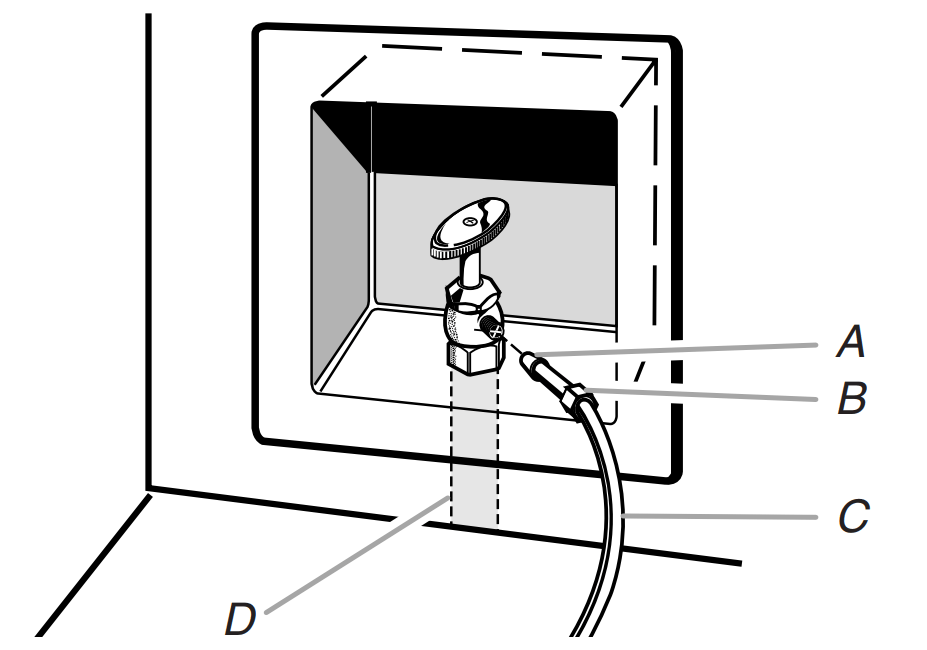
A. Sleeve
B. Nut
C. Copper tubing (to refrigerator)
D. Household supply line (1⁄2" minimum)
4. Now you are ready to connect the copper tubing to the shutoff valve. Use ¹⁄₄" (6.35 mm) OD soft copper tubing to connect the shutoff valve and the refrigerator.
■ Ensure that you have the proper length needed for the job. Be sure both ends of the copper tubing are cut square.
■ Slip compression sleeve and compression nut onto copper tubing as shown. Insert end of tubing into outlet end squarely as far as it will go. Screw compression nut onto outlet end with adjustable wrench. Do not overtighten.
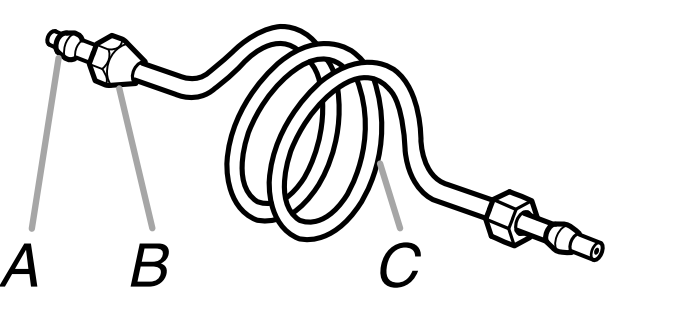 | A. Compression sleeve B. Compression nut C. Copper tubing |
5. Place the free end of the tubing into a container or sink, and turn on main water supply to flush out tubing until water is clear. Turn off shutoff valve on the water pipe.
NOTE: Always drain the water line before making the final connection to the inlet of the water valve, to avoid possible water valve malfunction.
6. Bend the copper tubing to meet the water line inlet, which is located on the back of the refrigerator cabinet as shown. Leave a coil of copper tubing to allow the refrigerator to be pulled out of the cabinet or away from the wall for service.
Connect to Refrigerator
Follow the connection instructions specific to your model.
Style 1
1. Remove plastic cap from water valve inlet port. Attach the copper tube to the valve inlet using a compression nut and sleeve as shown. Tighten the compression nut. Do not overtighten. Confirm copper tubing is secure by pulling on copper tubing.
2. Create a service loop with the copper tubing. Avoid kinks when coiling the copper tubing. Secure copper tubing to refrigerator cabinet with a “P” clamp.
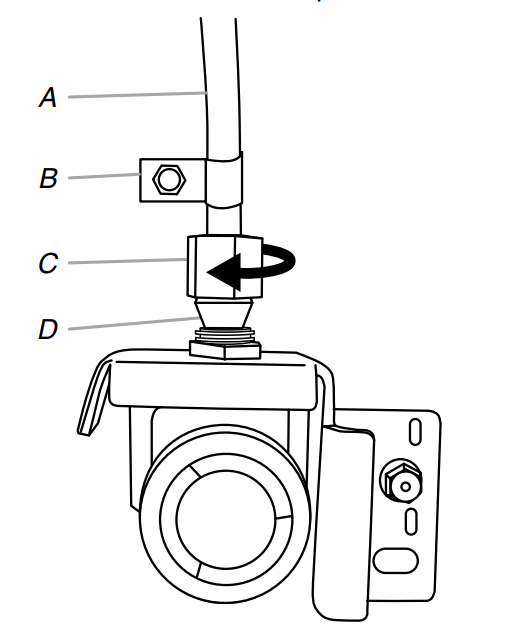 | A. Copper tubing C. Compression nut |
3. Turn on water supply to refrigerator and check for leaks. Correct any leaks.
Style 2
1. Unplug refrigerator or disconnect power.
2. Remove and discard the short, black plastic part from the end of the water line inlet.
3. Thread the nut onto the end of the tubing. Tighten the nut by hand. Then tighten it with a wrench two more turns. Do not overtighten.
NOTE: To avoid rattling, be sure the copper tubing does not touch the cabinet’s side wall or other parts inside the cabinet.
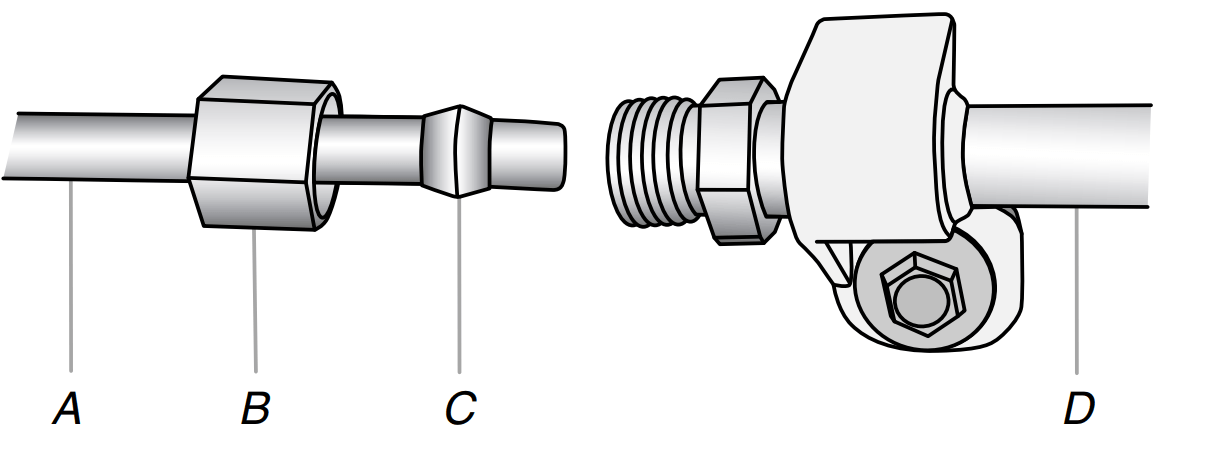 | A. Household water line C. Ferrule (purchased) |
4. Install the water supply tube clamp around the water supply line to reduce strain on the coupling.
5. Turn shutoff valve ON.
6. Check for leaks. Tighten any connections (including connections at the valve) or nuts that leak.
7. On some models, the ice maker is equipped with a built-in water strainer. If your water conditions require a second water strainer, install it in the ¹⁄₄" (6.35 mm) water line at either tube connection. Obtain a water strainer from your appliance dealer.
FILTERS AND ACCESSORIES
Water Filtration System
Do not use with water that is microbiologically unsafe or of unknown quality without adequate disinfection before or after the system. Systems certified for cyst reduction may be used on disinfected waters that may contain filterable cysts.
Install the Water Filter
1. Locate the accessory packet in the refrigerator and remove the water filter.
2. Take the water filter out of its packaging and remove the cover from the O-rings. Be sure the O-rings are still in place after the cover is removed.
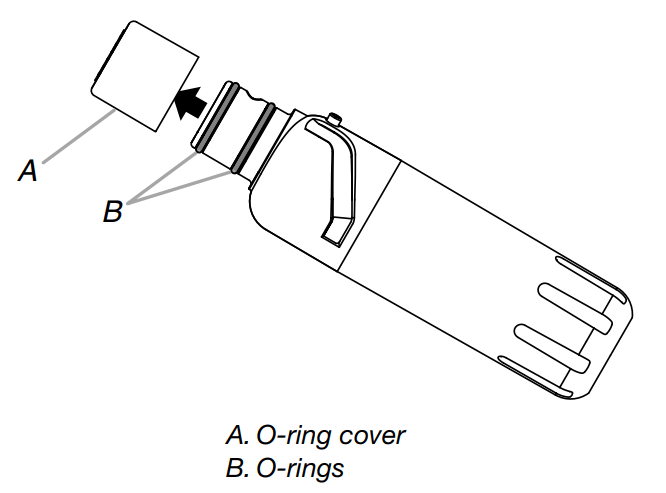
3. The water filter compartment is located in the right-hand side of the refrigerator ceiling. Push up on the compartment door to release the catch, then lower the door.
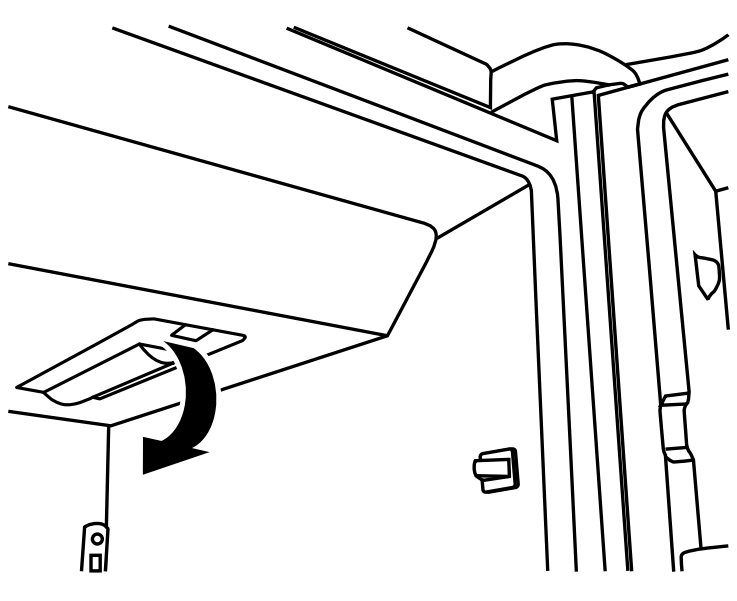
4. Align the arrow on the water filter label with the cutout notch in the filter housing and insert the filter into the housing.
5. Turn the filter clockwise 90 degrees (¹⁄₄ turn), until it locks into the housing.
NOTE: If the filter is not correctly locked into the housing, the water dispenser will not operate. Water will not flow from the dispenser.
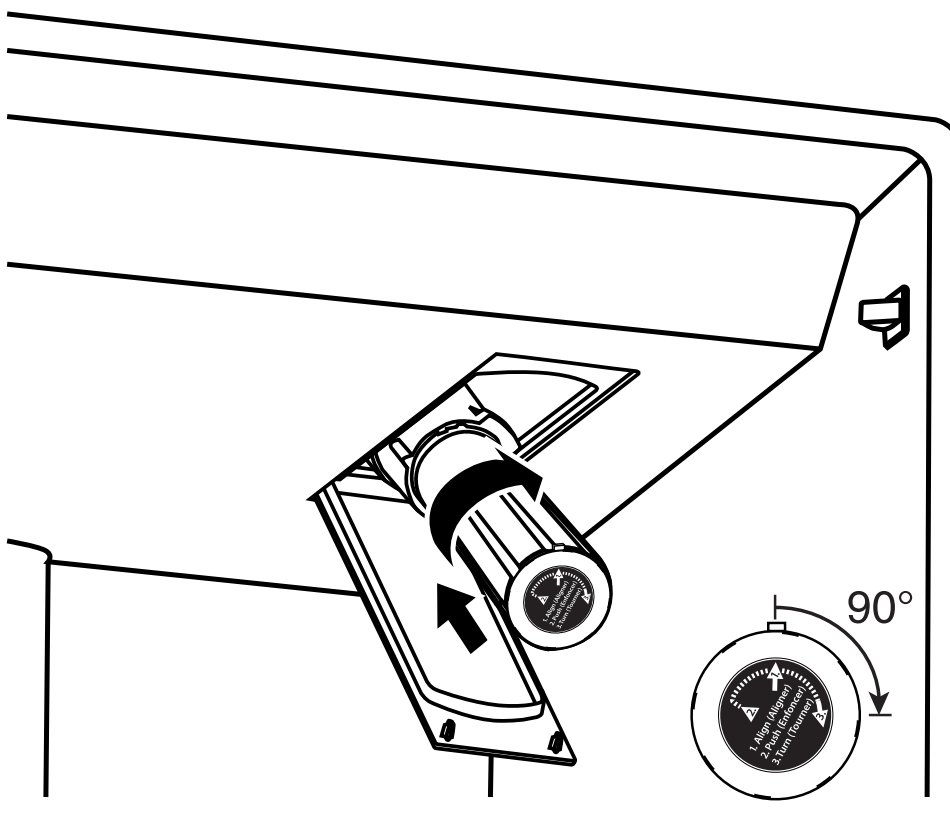
6. While the compartment door is still open, lift the filter up into the compartment. Then, close the filter compartment door completely.
7. Flush the water system.
IMPORTANT: If you do not flush the water system, you may experience dripping and/or decreased flow from the water dispenser.
The Water Filter Status Light
Press OPTIONS on the control panel to launch the Options menu. Press OPTIONS, under Filter Status, again to display the percentage of filter life remaining (from 99% to 0%). Press ICE/ WATER, under Back, to return to the Normal screen. The water filter status lights will help you know when to change your water filter.
■ ORDER FILTER (yellow) - it is almost time to change the water filter. While you are dispensing water, “Order Filter” will blink seven times and sound an alert tone three times.
■ REPLACE FILTER (red) - Replace the water filter. While you are dispensing water, “Replace Filter” will blink seven times and an alert tone will sound three times.
■ RESET the water filter status tracking feature. After you replace the disposable filter with a new filter, closing the filter compartment door will automatically reset the filter status tracking feature. See “Using the Control(s).”
NOTE: “REPLACE FILTER” will remain illuminated if a filter is not installed or is installed incorrectly.
Replace the Water Filter
1. Locate the water filter compartment in the right-hand side of the refrigerator ceiling. Push up to release and lower the compartment door.
2. Turn the water filter counterclockwise (to the left), and pull it straight out of the compartment.
NOTE: There may be some water in the filter. Some spilling may occur. Use a towel to wipe up any spills.
3. Install the replacement water filter by following steps 2 through 7 in the “Install the Water Filter” section.
Install Air Filter
An air filter is 15 times more powerful than baking soda at reducing common food odors inside the refrigerator. On some models, your refrigerator's accessory packet includes an air filter, which must be installed prior to use.

Install Air Filter (on some models)
An air filter is 15 times more powerful than baking soda at reducing common food odors inside the refrigerator. On some models, your refrigerator's accessory packet includes an air filter, which must be installed prior to use.
Installing the Air Filter
Install the air filter behind the vented door, located on the rear wall near the top of the refrigerator compartment.
1. Remove the air filter from its packaging.
2. Lift open the vented door.
3. Snap the filter into place.

Installing the Filter Status Indicator
The filter comes with a status indicator, which should be activated and installed at the same time the air filter is installed.

1. Place the indicator face-down on a firm, flat surface.
2. Apply pressure to the bubble on the back of the indicator until the bubble pops to activate the indicator.
3. Lift open the vented air filter door. On some models, there are notches behind the door.
Models with notches:
■ With the indicator screen facing outward, slide the indicator down into the notches.
NOTE: The indicator will not easily slide into the notches if the bubble has not been popped.
■ Close the air filter door, and check that the indicator is visible through the window in the door.
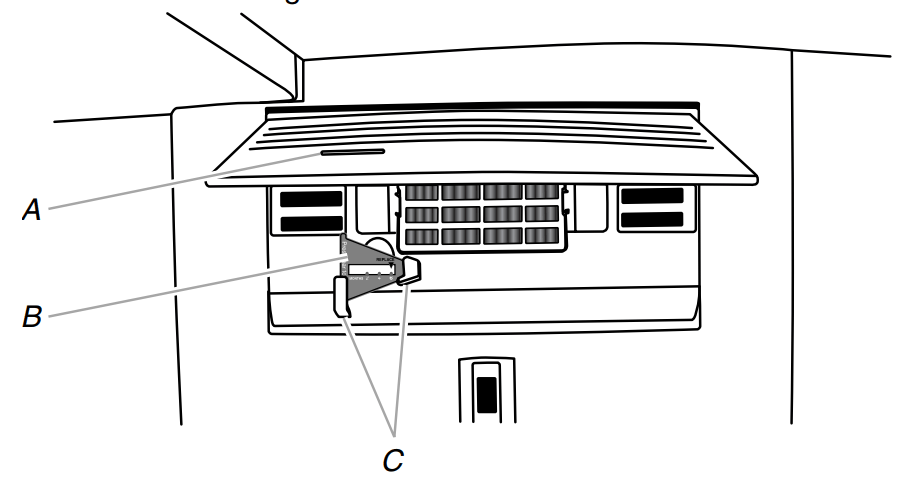 | A. Status indicator window B. Air filter status indicator C. Notches |
Models without notches:
■ Place the indicator somewhere it is easily visible - either inside the refrigerator, or elsewhere in your kitchen or home.
Replacing the Air Filter
The disposable air filter should be replaced every 6 months, when the status indicator has completely changed from white to red.
1. Remove the used air filter by squeezing in on the side tabs.
2. Remove the used status indicator.
3. Install the new air filter and filter status indicator using the instructions in the previous sections.
CARE & MAINTENANCE
Exterior Cleaning
Style 1 - Smooth Door
IMPORTANT: Damage to smooth finish due to improper use of cleaning products, or using non-recommended cleaning products, is not covered under the warranty. Sharp or blunt instruments will mar the finish.
DO USE | DO NOT USE |
|---|---|
| ✔ Soft, clean cloth | ✘ Abrasive cloths ✘ Paper towels or newsprint ✘ Steel-wool pads |
| ✔ Warm, soapy water - use a mild detergent | ✘ Abrasive powders or liquids ✘ Window sprays ✘ Ammonia ✘ Acidic or vinegar based cleaners ✘ Oven cleaners ✘ Flammable fluids |
NOTE: Paper towels scratch and may dull the clear coat of the painted door. To avoid possible damage use only soft clean clothes to polish and wipe the door.
Style 2 - Stainless Steel
IMPORTANT:
■ Damage to stainless steel finish due to improper use of cleaning products, or using non-recommended cleaning products, is not covered under the warranty.
DO USE | DO NOT USE |
|---|---|
| ✔ Soft, clean cloth | ✘ Abrasive cloths ✘ Paper towels or newsprint ✘ Steel-wool pads |
| ✔ Warm, soapy water | ✘ Abrasive powders or liquids ✘ Ammonia ✘ Citrus based cleaners ✘ Oven cleaners ✘ Acidic or vinegar-based cleaners |
| ✔ For heavy soil, ONLY a stainless steel cleaner designed for appliances. | ✘ Stainless steel cleaner is for stainless steel parts only! Do not allow the Stainless Steel Cleaner and Polish to come into contact with any plastic parts such as the trim pieces, dispenser covers or door gaskets. |
NOTE:
■ If unintentional contact does occur, clean plastic part with a sponge and mild detergent in warm water. Dry thoroughly with a soft cloth.
■ Just because a cleaner is a liquid does not mean it is nonabrasive. Many liquid cleansers formulated to be gentle on tile and smooth surfaces still damage stainless steel.
■ Citric acid permanently discolors stainless steel. To avoid damaging the finish of your stainless steel refrigerator:
Do not allow these substances to remain on the finish
✘ Mustard ✘ Tomato juice ✘ Marinara sauce | ✘ Citrus-based sauces ✘ Citrus-based products |
Interior Cleaning
1. Unplug refrigerator or disconnect power.
2. Hand wash, rinse, and dry removable parts and interior surfaces thoroughly. Use a clean sponge or soft cloth and a mild detergent in warm water.
■ NOTE: Do not use abrasive or harsh cleaners such as window sprays, scouring cleansers, flammable fluids, cleaning waxes, concentrated detergents, bleaches or cleansers containing petroleum products on plastic parts, interior and door liners or gaskets.
3. Plug in refrigerator or reconnect power.
Condenser Cleaning
There is no need for routine condenser cleaning in normal home operating environments. If the environment is particularly greasy or dusty, or there is significant pet traffic in the home, the condenser should be cleaned every 2 to 3 months to ensure maximum efficiency.
If you need to clean the condenser:
- Unplug refrigerator or disconnect power.
- Remove the base grille.
- Use a vacuum cleaner with a soft brush to clean the grille, the open areas behind the grille and the front surface area of the condenser.
- Replace the base grille when finished.
- Plug in refrigerator or reconnect power.
Vacations
If You Choose to Leave the Refrigerator On While You’re Away:
1. Use up any perishables and freeze other items.
2. If your refrigerator has an automatic ice maker, and is connected to the household water supply, turn off the water supply to the refrigerator. Property damage can occur if the water supply is not turned off.
3. If you have an automatic ice maker, turn off the ice maker.
NOTE: Depending on your model, raise the wire shutoff arm to OFF (up) position, or press the switch to OFF.
4. Empty the ice bin.
If You Choose to Turn Off the Refrigerator Before You Leave:
1. Remove all food from the refrigerator.
2. If your refrigerator has an automatic ice maker:
■ Turn off the water supply to the ice maker at least one day ahead of time.
■ When the last load of ice drops, raise the wire shutoff arm to the OFF (up) position or press the switch to OFF, depending on your model.
3. Turn off the Temperature control(s). See “Using the Control(s).”
4. Clean refrigerator, wipe it, and dry well.
5. Tape rubber or wood blocks to the tops of both doors to prop them open far enough for air to get in. This stops odor and mold from building up.
Moving
When you are moving your refrigerator to a new home, follow these steps to prepare it for the move.
1. If your refrigerator has an automatic ice maker:
■ Turn off the water supply to the ice maker at least one day ahead of time.
■ Disconnect the water line from the back of the refrigerator.
■ When the last load of ice drops, raise the wire shutoff arm to the OFF (up) position or press the switch to OFF, depending on your model.
2. Remove all food from the refrigerator and pack all frozen food in dry ice.
3. Empty the ice bin.
4. Turn off the Temperature control(s). See “Using the Control(s).”
5. Unplug refrigerator.
6. Clean, wipe, and dry thoroughly.
7. Take out all removable parts, wrap them well, and tape them together so they don’t shift and rattle during the move.
8. Depending on the model, raise the front of the refrigerator so it rolls more easily OR raise the leveling screws so they don't scrape the floor. See “Adjust the Door(s)” or “Door Closing and Door Alignment.”
9. Tape the doors closed and tape the power cord to the back of the refrigerator.
When you get to your new home, put everything back and refer to the “Installation Instructions” section for preparation instructions. Also, if your refrigerator has an automatic ice maker, remember to reconnect the water supply to the refrigerator.
TROUBLESHOOTING
PROBLEM | POSSIBLE CAUSES | SOLUTIONS |
|---|---|---|
| The refrigerator will not operate | Check electrical supply | Plug the power cord into a grounded 3 prong outlet |
| Do not use an extension cord. | ||
| Make sure there is power to the outlet. Plug in a lamp to see if the outlet is working. | ||
Reset a tripped circuit breaker. Replace any blown fuses. NOTE: If problems continue, contact an electrician. | ||
| Check controls | Make sure the controls are turned on. See “Using the Control(s).” | |
| New installation | Allow 24 hours following installation for the refrigerator to cool completely. NOTE: Adjusting the temperature controls to the coldest setting will not cool either compartment more quickly. | |
| Refrigerator control is in Showroom mode (on some models) | If the refrigerator is in Showroom mode, cooling is turned off and “Showroom” will be illuminated on the control panel. See “Using the Control(s)” for more information. | |
The motor seems to run too much | High efficiency compressor and fans | Larger, more efficient refrigerators run longer at lower, more energy efficient speeds. |
| The room or outdoor temperature is hot. | It is normal for the refrigerator to work longer under these conditions. For optimum performance, place the refrigerator in an indoor, temperature controlled environment. See “Location Requirements.” | |
| A large amount of warm food has been recently added. | Warm food will cause the refrigerator to run longer until the air cools to the desired temperature. | |
| The door(s) are opened too frequently or for too long. | Warm air entering the refrigerator causes it to run more. Open the door less often. | |
| The refrigerator door or freezer drawer is ajar. | Make sure the refrigerator is level. See “Door Closing and Door Alignment.” Keep food and containers from blocking the door. | |
| The refrigerator control is set too cold. | Adjust the refrigerator control to a less cold setting until the refrigerator temperature is as desired. | |
| The door or drawer gasket is dirty, worn, or cracked. | Clean or change the gasket. Leaks in the door seal will cause the refrigerator to run longer in order to maintain desired temperatures. | |
The lights do not work | Your refrigerator is equipped with LED lighting which does not need to be replaced. | If there is power to the refrigerator and the lights do not illuminate when a door or drawer is opened, call for service or assistance. |
| The dispenser light is set to OFF | On some models, the dispenser light will operate only when a dispenser paddle is pressed. If you want the dispenser light to stay on continuously, see “Water and Ice Dispensers.” | |
| Doors have been open longer than 10 minutes | Close the doors and drawer to reset, and open to resume lighted task. | |
Pantry Temperature Control not lit/ unresponsive | The refrigerator is in Cooling Off mode | Exit Cooling Off mode. See “Using the Control(s).” |
| The refrigerator controls’ initialization process did not complete successfully. | Unplug the refrigerator, wait 5 seconds. Plug in the refrigerator, and wait 30 seconds before opening any of the refrigerator doors or touching the control panel. |
Noise
PROBLEM | POSSIBLE CAUSES | SOLUTIONS |
|---|---|---|
The refrigerator seems noisy Below are listed some normal sounds with explanations. | The compressor in your new refrigerator regulates temperature more efficiently while using less energy, and operates quietly. Due to this reduction in operating noise you may notice unfamiliar noises that are normal. | |
Sound of the compressor running longer than expected | High-efficiency compressor and fans | Larger, more efficient refrigerators run longer at lower, more energy efficient speeds. |
Pulsating/Whirring | Fans/compressor adjusting to optimize performance during normal compressor operation | This is normal. |
Popping | Contraction/expansion of inside walls, especially during initial cool-down | This is normal. |
Hissing/Dripping | Flow of refrigerant, or flow of oil in the compressor | This is normal. |
Vibration | The refrigerator may not be steady | Adjust the leveling screws and lower the leveling foot firmly against the floor. See “Door Closing and Door Alignment.” |
Rattling/Banging | Movement of the water lines against the refrigerator cabinet, or of items placed on top of the refrigerator cabinet | Move excess water line away from the refrigerator cabinet or fasten excess tubing to the cabinet. See “Connecting the Water,” or remove items from the top of the refrigerator. |
Sizzling | Water dripping on the heater during defrost cycle | This is normal. |
Water running/Gurgling | May be heard when ice melts during the defrost cycle and water runs into the drain pan | This is normal. |
Buzzing and Clicking | Heard when the water valve opens and closes to dispense water and/or fill the ice maker. | If the refrigerator is connected to a water line, this is normal. If the refrigerator is not connected to a water line, turn OFF the ice maker. |
Repetitive Clicking | Dual evaporator valve regulating the cooling operation | You may hear rapid repetitive clicking sounds as the unit switches from cooling one compartment to cooling the other. This sound is normal. |
Creaking/Cracking/Grinding | May be heard as ice is being ejected from the ice maker mold | This is normal. |
Clatter | May be heard when the ice falls into the ice storage bin | This is normal. |
Temperature and Moisture
PROBLEM | POSSIBLE CAUSES | SOLUTIONS |
|---|---|---|
Temperature is too warm | The refrigerator has just been installed. | Allow 24 hours following installation for the refrigerator to cool completely. |
| Cooling is turned off. | Turn on cooling. See “Using the Control(s).” | |
| The controls are not set correctly for the surrounding conditions. | Adjust the controls a setting colder. Check the temperature in 24 hours. See “Using the Control(s).” | |
| The door(s) are opened often or not closed completely. | Allows warm air to enter refrigerator. Minimize door openings and keep doors fully closed. | |
| A large load of food was recently added. | Allow several hours for refrigerator to return to normal temperature. | |
Temperature is too cold in the refrigerator/crisper | The refrigerator air vent(s) are blocked. | If the air vent located in the top, left, rear corner of the refrigerator compartment is blocked by items placed directly in front of it, the refrigerator will get too cold. Move items away from the air vent. |
| The controls are not set correctly for the surrounding conditions. | Adjust the controls a setting warmer. Check the temperature in 24 hours. See “Using the Control(s).” | |
| The ice storage bin is not in the correct position. | See “Ice Maker and Ice Storage Bin.” | |
Temperature is too cold in the pantry drawers | The control is not set correctly for the items stored in drawer. | Adjust the temperature setting. See “Temperature Controlled Drawer” in the “Refrigerator Features” section. |
There is interior moisture buildup NOTE: Some moisture buildup is normal. | The room is humid | A humid environment contributes to moisture buildup. |
The door(s) are opened often or not closed completely. | Allows humid air to enter the refrigerator. Minimize door openings and close doors completely. | |
The door is blocked open | Move food packages away from door. | |
A bin or shelf is in the way | Push bin or shelf back into the correct position. | |
Storing liquid in open containers | This adds humidity to the refrigerator interior. Keep all containers tightly covered. | |
There is frost/ice buildup in the freezer compartment | The drawer is opened often or left open. | Minimize drawer openings and close drawer completely after use. |
| Poor door seal | Ensure door seals are making full contact with the refrigerator cabinet to allow for an adequate seal. | |
| Temperature controls are not set correctly | See “Using the Control(s)” for recommended temperature settings. |
Ice and Water
PROBLEM | POSSIBLE CAUSES | SOLUTIONS |
|---|---|---|
The ice maker is not producing ice or is not producing enough ice | The refrigerator is not connected to a water supply or the water supply shutoff valve is not turned on. | Connect refrigerator to water supply and turn water shutoff valve fully open. |
| There is a kink in the water source line. | A kink in the line can reduce water flow. Straighten the water source line. | |
| The ice maker is not turned on. | Make sure the ice maker is on. See “Ice Maker and Ice Storage Bin.” | |
| The refrigerator has just been installed. | Wait 24 hours after ice maker installation for ice production to begin. Wait 3 days for full ice production. | |
| The refrigerator door is not closed completely. | Close the door firmly. If it does not close completely, see “The doors will not close completely.” | |
| A large amount of ice was recently removed. | Allow sufficient time for ice maker to produce more ice. See “Ice Maker and Ice Storage Bin” for ice production rates. | |
| An ice cube is jammed in the ice maker ejector arm. | Remove ice from the ejector arm with a plastic utensil. | |
| A water filter is installed on the refrigerator. | Remove the water filter and operate the ice maker. If ice volume improves, then the filter may be clogged or incorrectly installed. Replace filter or reinstall it correctly. | |
| A reverse osmosis water filtration system is connected to your cold water supply. | This can decrease water pressure. See “Water Supply Requirements.” | |
The ice cubes are hollow or small NOTE: This is an indication of low water pressure. | The water shutoff valve is not fully open. | Turn the water shutoff valve fully open. |
| There is a kink in the water source line. | A kink in the line can reduce water flow. Straighten the water source line. | |
| A water filter is installed on the refrigerator. | Remove filter and operate ice maker. If ice quality improves, then the filter may be clogged or incorrectly installed. Replace filter or reinstall it correctly. | |
A reverse osmosis water filtration system is connected to your cold water supply. | This can decrease water pressure. See “Water Supply Requirements.” | |
Questions remain regarding water pressure. | Call a licensed, qualified plumber. | |
Off-taste, odor or gray color in the ice or water | Newly installed refrigerator requires flush of water system. | Flush the water system. See “Water and Ice Dispensers” for water system flushing instructions. |
Recently installed or replaced plumbing connections. New plumbing connections can cause discolored or off-flavored ice and water. | Discard the ice and wash the ice storage bin. Flush the water system with 3 gal. (12 L) of water. Allow 24 hours for the ice maker to make new ice, and discard the first 3 batches of ice produced. | |
Using a water supply connection type other than recommended. | It is recommended to use copper tubing or Whirlpool supply line, Part Number 8212547RP See “Connect to Water Line.” | |
The ice has been stored too long. | Discard ice. Wash ice storage bin. Allow 24 hours for ice maker to make new ice. | |
The water has been stored too long. | Dispense at least 1 qt (1 L) of water per week to maintain a fresh supply. | |
Odor from stored food has transferred to the ice. | Use airtight, moisture proof packaging to store food. | |
There are minerals (such as sulfur) in the water. | A water filter may need to be installed to remove the minerals. | |
There is a water filter installed on the refrigerator. | Gray or dark discoloration in ice may indicate that the water filtration system needs additional flushing. Flush the water system after installing and before using a new water filter. See “Water and Ice Dispensers” for water filter flushing instructions. | |
The water filter needs to be replaced. | Replace the disposable water filter at least every 6 months or when indicated. See “Water Filtration System.” | |
The water and ice dispenser will not operate properly | The refrigerator is not connected to a water supply or the water supply shutoff valve is not turned on. | Connect the refrigerator to the water supply and turn the water shutoff valve fully open. |
There is a kink in the water source line | A kink in the water line can reduce water flow from the water dispenser and result in hollow or irregular shaped ice. Straighten the water source line. | |
The refrigerator has just been installed. | Flush and fill the water system. See “Water and Ice Dispensers.” | |
The water pressure to the house is not at or above 35 psi (241 kPa). | The water pressure to the house determines the flow from the dispenser. See “Water Supply Requirements.” | |
A reverse osmosis water filtration system is connected to your cold water supply. | A reverse osmosis water filtration system can decrease water pressure. See “Water Supply Requirements.” | |
The water filter may be clogged. | Remove the water filter and operate dispenser. If water flow increases, your filter is clogged and needs to be replaced. See “Water Filtration System.” | |
The water filter is installed incorrectly | Remove the water filter and reinstall. See “Water Filtration System.” | |
The refrigerator door or freezer drawer is not closed completely. | Close the door or drawer firmly. If it does not close completely, see “The doors will not close completely.” | |
The refrigerator doors were recently removed. | Make sure the water dispenser wire/tube assembly has been properly reconnected at the top of the refrigerator door. See “Refrigerator Doors and Drawer.” | |
Ice is clogged in the ice storage bin or ice is blocking the ice delivery chute. | Remove the ice clogging the storage bin and delivery chute, using a plastic utensil if necessary. Clean the ice delivery chute and the bottom of the ice storage bin using a warm, damp cloth, then dry both thoroughly. To avoid clogging and to maintain a fresh supply of ice, empty the storage bin and clean both the storage bin and delivery chute every 2 weeks. | |
The ice dispenser jams while dispensing crushed ice | Crushed ice is blocking the ice delivery chute. | Switch from crushed ice to cubed ice to clear the ice dispenser. Then switch back to crushed ice. |
Water is leaking or dripping from the dispenser system NOTE: A few drops of water after dispensing is normal. | The glass was not held under the dispenser long enough. | Hold the glass under the dispenser 2 to 3 seconds after releasing the dispenser lever. |
Water continues to drip from the dispenser beyond the first few drops. | The refrigerator has just been installed. | Flushing the water system removes the air from the lines which causes the water dispenser to drip. Flush the water system. See “Water and Ice Dispensers.” |
The water filter was recently installed or replaced. | Flushing the water system removes the air from the lines which causes the water dispenser to drip. Flush the water system. See “Water and Ice Dispensers.” | |
Water is leaking from the back of the refrigerator | The water line connections were not fully tightened. | See “Connecting the Water.” |
Recently removed the doors and did not fully tighten water line connection | See “Refrigerator Doors and Drawer.” | |
Water from the dispenser is warm | Water from the dispenser is chilled to 50°F (10°C). | This is normal. |
The refrigerator has just been installed. | Allow 24 hours after installation for the water supply to cool completely. | |
A large amount of water was recently dispensed. | Allow 3 hours for the water supply to cool completely. | |
Water has not been recently dispensed. | The first glass of water may not be cool. Discard the first glass of water dispensed. | |
The refrigerator is not connected to a cold water pipe. | Make sure the refrigerator is connected to a cold water pipe. See “Water Supply Requirements.” |
Doors
PROBLEM | POSSIBLE CAUSES | SOLUTIONS |
|---|---|---|
| The doors will not close completely | The door is blocked open. | Move food packages away from door. |
| A bin or shelf is in the way. | Push bin or shelf back into the correct position. | |
| Recently installed | Remove all packaging materials. | |
| The doors are difficult to open | The door gaskets are dirty or sticky. | Clean gaskets and contact surfaces with mild soap and warm water. Rinse and dry with soft cloth. |
| The doors appear to be uneven | The doors need to be aligned, or the refrigerator needs to be leveled. | See “Refrigerator Leveling, Door Closing and Alignment.” |
| The refrigeratoris unsteady or it rolls forward when opening and closing doors | The refrigerator brake feet are not snug against the floor | Remove the base grille. Turn both brake feet (one on each side) clockwise, the same amount, until they are snug against the floor. See “Refrigerator Leveling, Door Closing and Alignment.” |
See other models: JLRP430WP YWED80HEBC 5MT519SFEH NED4400XQ WTW5860SW
